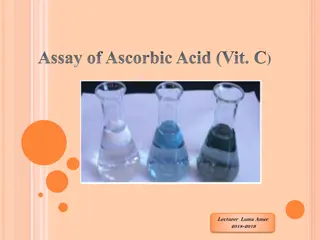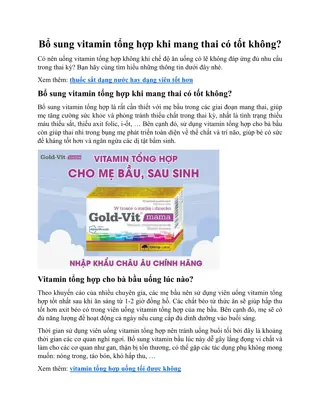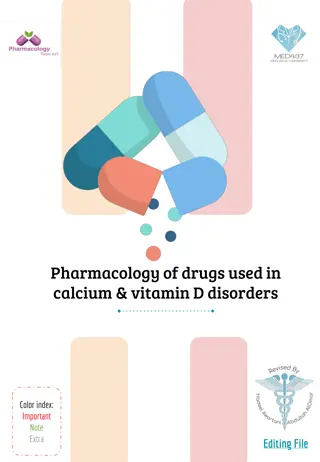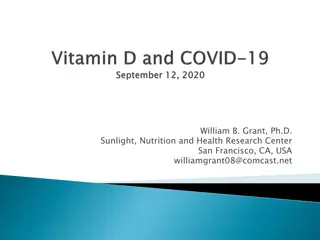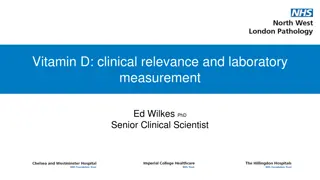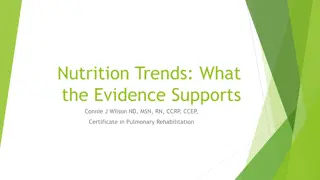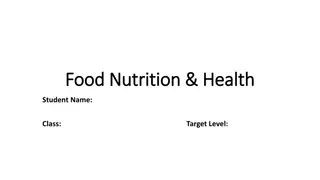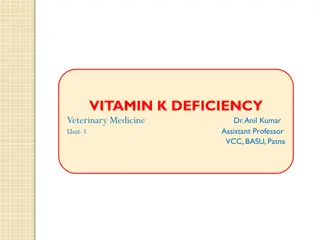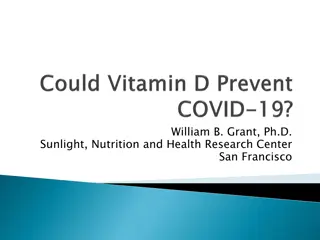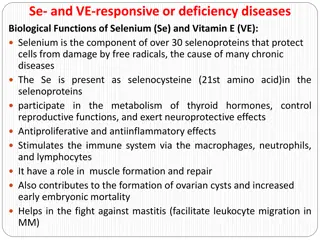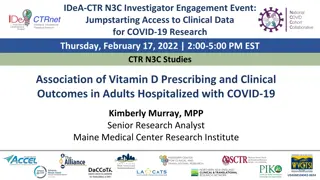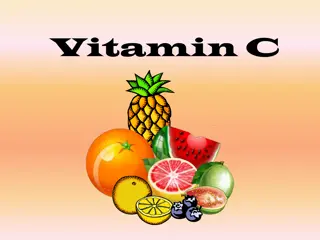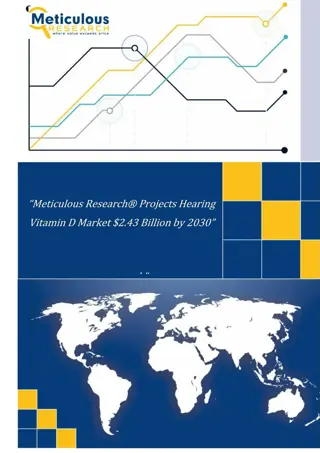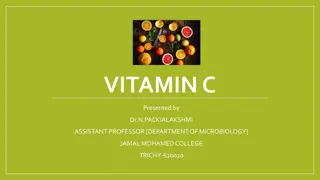Vitamin D's Impact on Health: Insights from Research
Explore how Vitamin D influences gene expression, lowers COVID-19 risk, and affects infectious diseases. Discover mechanisms, supplementation benefits, and recommendations for Vitamin D in chronic conditions. Insights from studies shed light on the importance of Vitamin D for overall health.
Download Presentation

Please find below an Image/Link to download the presentation.
The content on the website is provided AS IS for your information and personal use only. It may not be sold, licensed, or shared on other websites without obtaining consent from the author.If you encounter any issues during the download, it is possible that the publisher has removed the file from their server.
You are allowed to download the files provided on this website for personal or commercial use, subject to the condition that they are used lawfully. All files are the property of their respective owners.
The content on the website is provided AS IS for your information and personal use only. It may not be sold, licensed, or shared on other websites without obtaining consent from the author.
E N D
Presentation Transcript
William B. Grant, PhD Sunlight, Nutrition and Health Research Center San Francisco, CA, USA williamgrant08@comcast.net
Disclosure I receive funding from Bio-Tech Pharmacal, Inc. (Fayetteville, AR, USA), a supplier of research-grade vitamin D at low cost. I also work closely with two vitamin D-advocacy organizations: GrassrootsHealth.net VitaminDWiki.com
Outline Vitamin D overview Mechanisms of vitamin D in reducing COVID-19 risk Observational studies of 25(OH)D and SARS-CoV-2, COVID-19 Vitamin D supplementation of COVID-19 patients RCTs of vitamin D treatment of COVID-19 Seasonality of influenza and COVID-19 Hill s criteria for causality in a biological system Recommendations for vitamin D re COVID-19 Vitamin D and chronic diseases For more information
How Vitamin D Affects Gene Expression Naila Sattar et al. Letters in Health and Biological Sciences 2019-04-29
Influence of Vitamin D Status and Vitamin D3Supplementation on Genome Wide Expression of White Blood Cells Figure 5. Heatmaps of vitamin D responsive genes affected by vitamin D status. Before supplementation (light green) four subjects were vitamin D deficient with 25(OH)D of 41 11 nmol/L (dark purple) and the other four subjects were insufficient or sufficient with a 25(OH)D of 69 21 nmol/L(light purple). After supplementation (dark green) serum levels of 25(OH)D in vitamin D insufficient/sufficient subjects increased to 88 21 nmol/L (light purple) and in the vitamin deficient subjects increased to 25(OH)D of 63 12 nmol/L(dark purple). Hossein-nezhad A, Spira A, Holick MF PLoS One 2013;8: e58725.
Vitamin D Mechanisms Re Infectious Diseases Angiotensin II, Ang II Myosin light chain kinase, MLCK Renin-angiotensin system, RAS Matrix metalloproteinase-9, MMP-9 Dos Santos et al. Arch Endocrinol Metab. 2020;S2359-39972020005006214.
Human Cathelicidin (LL37) Cathelicidin is a polypeptide with antimicrobial and antiendotoxin properties. Cathelicidin is induced from macrophages by the action of 1,25(OH)2D. It reduces survival of viruses by puncturing the their surface. It has been found to kill both bacteria and viruses.
CD4, cluster of differentiation 4 Cytokine Storms DIC, disseminated intravascular coagulation GM-CSF, granulocyte- macrophage colony- stimulating factor IFN-gamma, interferon-gamma IL, interleukin NK, natural killer TNF, Tumour Necrosis Factor Cytokine Storms: Understanding COVID-19. Mangalmurti N, Hunter CA. Immunity. 2020;53:19-25.
Innate and Adaptive Immune System B cells, white blood Cell of lymphocyte Subtype T cell, another white Blood cell Dendritic cell, a type Of phagocyte and a Type of antigen- Presenting cell found In tissues Hetta et al. Eur Rev Med Pharmacol Sci 2021
Does eNOS derived nitric oxide protect the young from severe COVID-19 complications? Nitric oxide (NO), which is the main intracellular antiviral defence, has been shown to inhibit a wide array of viruses, including SARS-CoV-1. Additionally, the increased risk of death with diseases that have underlying endothelial dysfunction suggest that endothelial NO synthase-derived nitric oxide could be the main defence mechanism. NO decreases dramatically in the elderly, the hyperglycaemic and the patients with low levels of vitamin D. Guan et al. Ageing Res Rev. 2020;64:101201.
SARS-CoV-2 positivity rates and circulating 25(OH)D levels in the total population, U.S., measured by Quest Diagnostics Based on tests for more than 190,000 patients who had serum 25(OH)D tests within the past year. The 25(OH)D values were seasonally adjusted. 50 nmol/L 138 nmol/L Kaufman, Holick, PLoS One. 2020;15(9):e0239252.
Effects of Race and 25(OH)D on SARS-CoV-2 seropositivity in the US The findings regarding race/ethnicity and seropositivity indicate that blacks and Hispanics have higher rates than whites primarily due to non-vitamin D effects. However, if blacks and Hispanics were to increase 25(OH)D concentrations by vitamin D supplementation, they could reduce seropositivity by about 30%
Black, Asian and Minority Ethnic (BAME) Physicians in the UK BAME physicians have higher rates of COVID-19 incidence and death than whites (Verma, 2021). BAME have lower 25(OH)D concentrations than whites due to darker skin, resulting in lower production of vitamin D, and Asians often have vegan or vegetarian diets, which can lower 25(OH)D by 20 nmol/L compared to meat-rich diet (Crowe, 2011). Thus, BAME, especially BAME physicians, should raise their 25(OH)D to 120 to 150 nmolL. Verma et al. Clin Med (Lond). 2021;21:e161-e165. Crowe et al. Public Health Nutr. 2011;14:340-6.
Observational Studies of COVID-19 with Respect to serum 25(OH)D To date there have been many reports of COVID-19 with respect to serum 25(OH)D concentration with most reporting inverse correlations with COVID-19 risk, severity and/or death. Serum 25(OH)D can be measured prior to COVID-19 and seasonally adjusted or at time of COVID-19 diagnosis. Although acute inflammatory illness reduces 25(OH)D concentration, the effect lasts only a few days.
Experimental Study in a French Nursing Home Population: 66 residents of a nursing home in France with recently diagnosed COVID-19; mean age 88 9 yrs. Intervention: 57 had received 80,000 IU vitamin D the previous month or within one week after diagnosis of COVID-19. Outcome: During follow up of 36 17 days, 83% of supplemented residents survived; only 44% of comparator group (N = 9) survived; aHR = 0.11 (95% CI, 0.03 to 0.48, p=0.003). Annweiler et al. J Steroid Biochem Mol Biol. 2020 Nov;204:105771
"Effect of Calcifediol Treatment and best Available Therapy versus best Available Therapy on ICU Admission and Mortality Among Patients Hospitalized for COVID-19: A Pilot Randomized Clinical study Cordoba, Spain All hospitalized patients (76) received as best available therapy the same standard care of a combination of hydroxychloroquine and azithromycin. Eligible patients (50) were allocated to take oral calcifediol (0.532 mg), or not. Patients in the calcifediol treatment group continued with oral calcifediol (0.266 mg) on day 3 and 7, and then weekly until discharge or ICU admission. (Calcifediol is 25(OH)D3 and week one treatment: 130,000 IU vitamin D3. Calcifediol acts faster that vitamin D by a day or two due to bypassing conversion in the liver.) Entrenas Castillo et al. J Steroid Biochem Mol Biol. 2020 Oct;203:105751
Results of the Pilot Randomized Clinical study Entrenas Castillo et al., 2020 Of 50 patients treated with calcifediol, one required admission to the ICU (2%), while of 26 untreated patients, 13 required admission (50 %) p < 0.001. Univariate Risk Multivariate Risk Estimate Odds Ratio for ICU in patients with calcifediol treatment vs. without calcifediol treatment ICU (adjusting by Hypertension and T2DM): 0.03 (95 %CI: 0.003-0.25). Of the patients treated with calcifediol, none died, and all were discharged, without complications. The 13 patients not treated with calcifediol, who were not admitted to the ICU, were discharged. Of the 13 patients admitted to the ICU, two died and the remaining 11 were discharged.
Meta-analysis of Vitamin D Treatment of COVID-19
Meta-analysis vitamin D RCTs https://vdmeta.com/
Relation of 25(OH)D to Infectious Disease Outcomes (Whittle) Vanegas-Cedillo et al. Serum Vitamin D levels are associated with increased COVID-19 severity and mortality independent of visceral adiposity. medRxiv https://vitamindstopscovid.info /03-not-orphan/
Aging, Immunity, and COVID-19: How Age Influences the Host Immune Response to Coronavirus Infections? Aging causes numerous biological changes in the immune system, which are linked to age-related illnesses and susceptibility to infectious diseases. Age-related changes influence the host immune response and therefore not only weaken the ability to fight respiratory infections but also to mount effective responses to vaccines. Immunosenescence and inflamm-aging are considered key features of the aging immune system wherein accumulation of senescent immune cells contribute to its decline and simultaneously increased inflammatory phenotypes cause immune dysfunction. Bajaj et al. Front Physiol. 2021;11:571416.
Seasonality of Viral Infections You Li et al. J Infect Dis. 2020;222:1090-1097.
Low Temperature and Low UV Indexes Correlated with Peaks of Influenza Virus Activity in Northern Europe during 2010 2018 Ianevski et al. Viruses. 2019;11:207.
Low Temperature and Low UV Indexes Correlated with Peaks of Influenza Virus Activity in Northern Europe during 2010 2018 Implications: Influenza rates are reduced in winter at high latitudes due to lower temperature, UV dose, and humidity giving rise to increased viability of the virus outside the human body.
Mean Monthly 25OHD in Men and Women Aged 45 yrs, UK, 2002-4 Men on left, women on right Hypponen and Power, Am J Clin Nutr. 2007
Exposure Times Near Noon for Production lf 400 IU Vitamin D3 At 42 N (Boston) at The spring equinox, it takes 40 minutes to produce 4000 IU for 25% of the body area exposed. Black: short times; Red: long times. Engelsen, Nutrients 2010, 2, 482-495
COVID-19 Case and Death Rates in the UK through April 27, 2021
Hills Criteria for Causality in a Biological System (Hill, 1965) Strength of association Consistency Temporality Biological gradient Plausibility (e.g., mechanisms) Coherence with known facts of biology and disease Experiment (e.g., randomized controlled trial) Analogy Added later: Account for confounding factors
Over 200 Scientists & Doctors Call for Increased Vitamin D Use To Combat COVID-19 #VitaminDforAll (for questions or fact checking assistance, contact press@vitaminDforAll.org) Research shows low vitamin D levels almost certainly promote COVID-19 infections, hospitalizations, and deaths. Given its safety, we call for immediate widespread increased vitamin D intakes. Vitamin D modulates thousands of genes and many aspects of immune function, both innate and adaptive. The scientific evidence1shows that: Higher vitamin D blood levels are associated with lower rates of SARS-CoV-2 infection. Higher D levels are associated with lower risk of a severe case (hospitalization, ICU, or death). Intervention studies (including RCTs) indicate that vitamin D can be a very effective treatment. Many papers reveal several biological mechanisms by which vitamin D influences COVID-19. Causal inference modelling, Hill s criteria, the intervention studies & the biological mechanisms indicate that vitamin D s influence on COVID-19 is very likely causal, not just correlation.
Clinical Determinants of Severe COVID-19 Disease - Meta-Analysis Pooled odds ratio (pOR) was highest for chronic obstructive pulmonary disease (pOR: 2.92, 95% CI: 1.70-5.02), followed by obesity (pOR: 2.84, 95% CI: 1.19-6.77), malignancy (pOR: 2.38, 95% CI: 1.25-4.52), diabetes (pOR: 2.29, 95% CI: 1.56-3.39), hypertension (pOR: 1.72, 95% CI: 1.23-2.42), cardiovascular disease (pOR: 1.61, 95% CI: 1.31-1.98) and chronic kidney disease (pOR: 1.46, 95% CI: 1.06-2.02), for predicting severe COVID-19. Sahu et al. J Glob Infect Dis. 2021 Jan 29;13(1):13-19.
Other Benefits of UVB Exposure and Vitamin D Supplementation Reduced risk of Cancer incidence and death Diabetes mellitus Cardiovascular disease Hypertension Many other types of disease Increased life expectancy
Types of Studies Regarding UVB and Vitamin D and Health Outcomes Ecological, either temporal or geological with respect to solar UVB doses Observational, based on UVB exposure or 25(OH)D concentrations Open-label supplementation Randomized controlled trials Studies of mechanisms
Breast cancer risk markedly lower with serum 25- hydroxyvitamin D concentrations 60 vs <20 ng/ml McDonnell et al., (GrassrootsHealth.net) PLoS One, 2018
Randomized Controlled Trials Most vitamin D RCTs have been conducted based on guidelines for pharmaceutical drugs and have largely failed to support findings from observational studies. Assumes no other source of the drug; Assumes a linear dose-response relationship. They should be based on guidelines for nutrients as outlined by Heaney (2014) and Grant and Boucher (2018). Baseline 25(OH)D should be measured and used in selection of participants; The vitamin D dose should be large enough to raise 25(OH)D to where it would have an impact on outcome Achieved 25(OH)D should be measured and used for evaluation.
The VITamin D and OmegA-3 TriaL (VITAL) VITAL enrolled over 25,000 participants including over 5000 Blacks. Vitamin D treatment was 2000 IU/d vitamin D3. Mean baseline 25(OH)D for participants who supplied values was near 78 nmol/L. In analyses that excluded 1 or 2 years of follow-up, the rate of death from cancer was significantly lower with vitamin D than with placebo (HR = 0.79 [95% CI, 0.63 to 0.99], and HR = 0.75 [95% CI, 0.59 to 0.96], respectively). Cancer incidence for Blacks had HR = 0.77 (0.59 to 1.01). For participants with BMI <25 kg/m2, for cancer incidence, HR = 0.76 (0.63 to 0.90). Comment: Baseline 25(OH)D was too high, vitamin D dose was too low, and all participants could take 600 to 800 IU/d vitamin D. Manson et al. New England J Medicine, 2019
Type 2 Diabetes Mellitus Risk vs. 25(OH)D from a Meta-Analysis Song et al. Diabetes Care. 2013;36(5):1422-8.
Intratrial Exposure to Vitamin D and New-Onset Diabetes Among Adults With Prediabetes: Secondary analysis from the Vitamin D and Type 2 Diabetes (D2d) study (Pittas et al., 2019) 4000 IU/d vitamin D3 was given in the treatment arm. The hazard ratios for diabetes among participants treated with vitamin D who maintained intratrial 25(OH)D levels of 100-124 and 125 nmol/L were 0.48 (0.29-0.80) and 0.29 (0.17-0.50), respectively, compared with those who maintained a level of 50-74 nmol/L. Dawson-Hughes et al. Diabetes Care, 2020
Vitamin D Deficiency and Risk of Cardiovascular Disease Incidence and Death Meta-Analysis Gholami et al. BMC Cardiovascular Disorders. 2019
Open-label Study of Reducing Hypertension with Vitamin D We assessed 8155 participants in a community-based program to investigate the association between serum 25(OH)D status and blood pressure (BP) and the influence of vitamin D supplementation on hypertension. Participants were provided vitamin D supplements to reach a target serum 25(OH)D > 100 nmol/L. At baseline, 592 participants (7.3%) were hypertensive; of those, 71% were no longer hypertensive at follow-up (12 3 months later). There was a significant negative association between BP and serum 25(OH)D level (systolic BP: coefficient = -0.07, p < 0.001; diastolic BP: coefficient = -0.1, p < 0.001). Reduced mean systolic (-18 vs. -14 mmHg) and diastolic (-12 vs. -12 mmHg) BP, pulse pressure (-5 vs. -1 mmHg) and mean arterial pressure (-14 vs. -13 mmHg) were not significantly different between hypertensive participants who did and did not take BP-lowering medication. Mirhossseini et al. Nutrients. 2017;9:1244.
All-cause Mortality Rate vs. 25(OH)D Meta-analysis Over 30 observational studies Were included in this meta- analysis. Garland CF, et al. Meta-analysis of all-cause mortality according to serum 25-hydroxyvitamin D. Am J Pub Health. 2014 Aug;104(8):e43-50.
Avoidance of sun exposure is a risk factor for all-cause mortality: Study from southern Sweden. Lindqvist et al. J Intern Med 2014
Disease Incidence Prevention by 25(OH)D GrassrootsHealth.net
25(OH)D vs. Vitamin D Supplementation, GrassrootsHealth.net
Human serum 25(OH)D response to extended oral dosing with cholecalciferol 250 g 125 g 25 g 0 g Heaney et al. Am J Clin Nutr. 2003 Jan;77(1):204-10.
Supplements Associated with Vitamin D Magnesium used by enzymes that convert vitamin D to the various metabolites. Vitamin K2 helps direct calcium to the hard tissues rather than to the soft tissues such as the vascular system. Vitamin C helps with antioxidant regulation, thereby sparing vitamin D from dealing with that function.
For Further Information Search for journal publications https://pubmed.ncbi.nlm.nih.gov/ https://scholar.google.com/ Vitamin D advocacy organizations Grassrootshealth.net VitaminDWiki.com (has a large collection of vitamin D information) William B. Grant, PhD, williamgrant08@comcast.net www.sunarc.org


